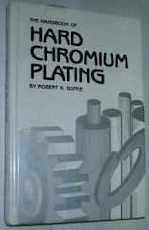
Curated with aloha by
Ted Mooney, P.E. RET

The authoritative public forum
for Metal Finishing 1989-2025

-----
Taper Problem on Chrome Plated Barrel Bores
Q. Hi all. We chrome plate the inside of gun barrel bores. We've recently had a rather odd problem. The barrel in question is approx. 80 inches long, with a 1" bore (rifled). Chrome thickness range is .007-.008".
We have plated these barrels successfully in any of 4 other tanks, with the deposit even the full length of the bore (no taper). We recently constructed a new chrome tank, the same depth as the others, but a little wider. Barrels plated in this tank typically have taper of .002" or even more, with the muzzle end coming out a lot heavier than the breech. All the other tanks, with identical solution chemistries, show almost no taper, and what little we get can be controlled by lowering the plating current, or raising the chrome:sulphate ratio. Barrels are suspended from the common cathode bars, muzzle end down. Anode and cathode connections are only made at the top (breech) end.
The older tanks used a common cathode buss (4 rectifiers on 2 buss bars, 2 on each), with the anode connections separate. The new tank had separate cathode and anode cabling with individual cathode bars (we use a mix of hard bussing and cabling on the other tanks, with no problems. We connected the cathode legs in the new tank together- no difference in results. We use low-pressure air for agitation (although we had installed eductors on a pump system on this new tank, but switched back to air to try to locate the source of the taper problem). The rectifiers are new Rapid units. We checked the output and amp-hr counters, they're perfect. We did connect one of these rectifiers to a barrel in another tank (connecting the cathode to the common cathode buss of that tank, and it plates OK. So basically, the setups are identical, except for the un-common cathode leg. Any ideas what's going on?
Sr Mfg Engineer - Saco, Maine, USA
January 8, 2008
|
A. Your assertion "the only thing different is the un-common cathode leg" says it all! Monterrey, NL, Mexico January 10, 2008 A. With a 1" bore, I will assume that you are plating a 25mm chain gun barrel. I also assume that you are using an internal anode. If the anode has a contact at the muzzle, I am going to guess that you have a better contact there, or the breech end has most of the contact out of solution and is heating up allowing more current to flow at the bottom which is kept cool by the solution. If this is not the case, I would take an easy way out and mask off part of the anode at the muzzle end. I assume that you are using some kind of standoff for this anode and the masking could become part of the standoff. - Navarre, Florida January 10, 2008 A. Hello George, Kansas City, Missouri January 11, 2008 |
Q. James- The connection is only at the breech- barrels are suspended in the solution muzzle-down, the anode and cathode connections are both out of the solution. No stop-off is used.
Ira- what does your electrical connection look like on your small diameter set-up?
- Saco, Maine
January 15, 2008
A. OK, you are getting plating electrons/ions bouncing off the bottom of the tank. Shorten your anodes to initially be at 1" higher than the muzzle. Depending on how close you are to the bottom of the tank, you will probably end up with the anode 3 inches higher than the tip of the muzzle.
I am shocked if you are plating the ID with out using an ID anode and not having a severe run out problem in the middle.
- Navarre, Florida
January 16, 2008
![]() Am I describing this wrong, James? There is an internal anode (platinum coated, niobium-clad copper, fixtured to be held rigidly centered in the barrel bore. The anode and cathode connections are both in the air, out of the solution. The tank is 11-1/2 feet deep, the barrel is almost 5 feet from the bottom of the tank. Incidentally, it looks like the problem was excessive trivalent, due to solution reacting with the adhesive used to hold the Koroseal panels to the tank. Thanks everyone.
Am I describing this wrong, James? There is an internal anode (platinum coated, niobium-clad copper, fixtured to be held rigidly centered in the barrel bore. The anode and cathode connections are both in the air, out of the solution. The tank is 11-1/2 feet deep, the barrel is almost 5 feet from the bottom of the tank. Incidentally, it looks like the problem was excessive trivalent, due to solution reacting with the adhesive used to hold the Koroseal panels to the tank. Thanks everyone.
- Saco, Maine, USA
January 22, 2008
Chrome plating I.D. of Tube
March 8, 2018Q. I need to be chrome plated the ID of SS 304L Tube having 57.80 mm dia. and 3400 mm long, wall thickness 3.5 mm. You are requested to suggest about the following:
1. Anode Size
2. Bath Concentration
3. Current in Amps
4. Plating duration
5. Is it possible to achieve in one setup?
Thanks & Regards,
Self - Bangalore, India
March 2018
by Robert K. Guffie

on AbeBooks
(rarely)
or eBay
(rarely)
or Amazon
(affil links)
A. Hi Suksmith. You have not introduced yourself so it's a bit hard to know the right starting point. May we assume that you have experience in hard chrome plating? If not, this is sure a tough part to start with :-)
1. The anode can probably be a copper or steel rod about 3400 mm long with lead plating and wrapping. It needs to be sufficient diameter to carry the current from question 3; moreover, it should probably be as large as possible per Guffie, with an ideal anode-cathode spacing of 1/4" - 3/4" .
2. I don't see a reason to not use whatever standard Sergeant bath or HEEF-25 you normally use.
3. Figure on about 2 A /in2 of plated area.
4. You have to advise required plating thickness before the plating time can be estimated.
5. The 304L probably needs sulfuric acid cathodic etching, so it may depend on exactly what you mean by "one setup".
Regards,

Ted Mooney, P.E. RET
Striving to live Aloha
finishing.com - Pine Beach, New Jersey
Q. We have a requirement of Hard chrome plating inside the SS 304 Tubes having ID 57. Plating thickness required is 0.01 - 0.10. Can we have following datas -
1) Anode diameter
2) Current required in Amps
3) Bath solution need to be circulated?
Special Purpose Machineries - Bangalore, Karnataka, India
March 8, 2019
A. Hi Sukshith. Apologies if you didn't previously see my response, but we've appended your inquiry to the previous thread where it was asked and answered last year. Please try to phrase ongoing questions in terms of the suggestions already offered. Thanks!
Regards,

Ted Mooney, P.E. RET
Striving to live Aloha
finishing.com - Pine Beach, New Jersey
March 2019
A. Hi Sukshith,
Mr. Mooney explained it very well, I would like to add something to it. How will you pre-treat the inner diameter? How is the surface of inner diameter, in example, if it is a cold drawn pipe, you may probably need to machine the inner diameter first, like honing. If it is a polished pipe, than you are okay. You have to have a clean surface before any treatment.
Best regards.
- Istanbul, Turkey
April 20, 2019
Q, A, or Comment on THIS thread -or- Start a NEW Thread
